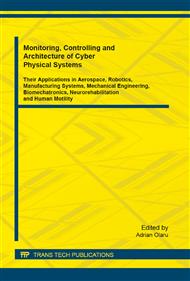[2]
Gonzalez EG et al. The physiological basis of rehabilitation medicine. Boston; Butterworth – Heinemann; 1994; 413-46.
Google Scholar
[3]
Waters R. The energy expenditure of normal and pathologic gait. Gait Posture 1999; 9: 207-31.
DOI: 10.1016/s0966-6362(99)00009-0
Google Scholar
[4]
Kuo AD et al. Dynamic principles of gait and their clinical implication. Phys Ther 2010; 90: 157-74.
Google Scholar
[5]
Inman VT et al. Human walking. Baltimore, Williams& Wilkins (1981).
Google Scholar
[6]
Holt KG et al. Predicting the minimal energy costs of human walking. Med Sci in Sports Exerc 1991; 23: 491-498.
Google Scholar
[7]
Gordon K et al. Metabolic and mechanical energy costs of reducing vertical Centre of Mass movement during gait. Arch Phys Med Rehabil 2009; 90: 136-144.
DOI: 10.1016/j.apmr.2008.07.014
Google Scholar
[8]
Engelbert RH et al. Aerobic capacity in children with hemophilia. J Pediatr 2008; 152: 833-8.
Google Scholar
[9]
Koch et al. Physical fitness in children with hemophilia. Arch Phys Med Rehabil 1984; 65: 324-6.
Google Scholar
[10]
Broderick CR et al. Fitness and quality of life in children with hemophilia. Haemophilia 2010; 16: 118-123.
Google Scholar
[11]
Van der Net J et al. Physical fitness, functional ability and quality of life in children with severe hemophilia: a pilot study. Haemophilia 2006; 12: 494-9.
DOI: 10.1111/j.1365-2516.2006.01307.x
Google Scholar
[12]
Lobet S et al. Impact of multiple joint impairments on the energetics and mechanics of walking in patients with haemophilia. Haemophilia 2012; 19: 66-72.
DOI: 10.1111/hae.12001
Google Scholar
[13]
Hoejmans N et al. Measuring functional status: cross-sectional and longitudinal associations between performance and self – report. J Clin Epidemiol 1996; 49: 1103-10.
Google Scholar
[4]
Sasaki K et Al. Muscle mechanical work and elastic energy utilization during walking and running near the preferred gait transition speed. Gait Posture 2006; 23: 383-390.
DOI: 10.1016/j.gaitpost.2005.05.002
Google Scholar
[15]
Winiarski S et al. Mechanical energy fluctuation during walking of healthy and ACL reconstructed subjects. Acta Bioengineering Biomech 2008; 10: 57-63.
Google Scholar
[16]
Magnusson PS et al. Human tendon behaviour and adaptation in vivo. J Physiol 2008; 586: 71-81.
Google Scholar
[17]
Fukunaga T et al. In vivo behaviour of human muscle tendon during walking. Proc R Soc Lond B Biol Sci 2001; 268: 229-233.
Google Scholar
[18]
Kubo K et al. Effect of repeated muscle contractions on tendon structure in humans. Eur J Appl Physiol 2001; 84: 162-166.
Google Scholar
[19]
Ciobanu I., Berteanu M. Advanced Rehabilitation Technology. Applied Mechanics and Materials Vol. 186 (2012) pp.35-45.
DOI: 10.4028/www.scientific.net/amm.186.35
Google Scholar
[20]
Mihai Berteanu et al. Rationale in designing a new system for gait rehabilitation. 2014, Applied Mechanics and Materials. Vol. 555, pg 681.
DOI: 10.4028/www.scientific.net/amm.555.681
Google Scholar


